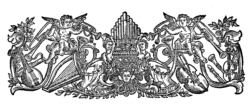Johann Valentin Rathgeber is most propbably the most well-known composer of Frankonia who is also regarded the most inspired and prolific petite master among the many monastic composers of his time. As a Southern German antipode to Telemann, he is a very important connecting link between Baroque and the Classical Era. Thus, he is one answer to the often asked question how Mozart was possible that soon after Bach. Rathgeber got famous mainly due to the so called "Tafelconfect of Ausgburg", a collection of amusing songs. However, his main area was sacred vocal music.
The touring exhibition "Valentin Rathgeber (1682-1750). Life – Oeuvre – Significance" trys to elucidate the phenomenon Rathgeber within different thematic areas by bringing him into line with his time and showing the contexts in which he worked.
Contrary to many of his contemporaries, Rathgeber had a very modern attitude in his compositions. He expressed not only a certain personal style synthesizing facility, brevity and suavity, but was responsive to the needs of his audience. In that respect, he could merchandise his compositions very successfully. He wrote appealing sacred music especially for small ensembles that was played and enjoyed till the middle of the 19th century in the Catholic regions.
Rathgeber was engaged in the whole of Europe and found sponsors in Germany, Switzerland, Austria and Hungary who helped funding his compositions. the following topics are addressed on 25 boards, two show cases and several free-standing exhibits:
1) Characterization of his time
2) Place of birth and infancy
3) Time in Würzburg
4) Time in Banz
5) Rathgeber's public relations tour
6) Patrons and sponsors
7) Rathgeber's music
8) Rathgeber Renaissance
Rathgeber still survives as a composer due to his oeuvre. That's why audioguides are offered since they could supply audio samples. A detailed exhibition catalogue explains all issues in a easily comprehensive way and presents further information.
 DE
DE 

